During the Regional Sustainability Report Card project, we realized that it was important not only to show the challenges facing the Clarenville-Bonavista-Isthmus Region, but also to highlight positive stories about individuals and organizations that are making a difference in their communities. We also wanted to counter the negative spin that is often put on rural Newfoundland communities with some needed good news from communities in the region. This was a challenge, because there are so many great initiatives underway in the region that are helping bring about positive change. In January-March 2016, we met with the following organizations to learn about their organizations and the inspiring initiatives that they have going on. We chose these organizations based on recommendations from Regional Council and other community leaders. Here are the Good News Stories that we encountered from each of the three sub-regions:
Isthmus of Avalon
Come-By-Chance Barachois 50+ Community Garden

Volunteers at the Come-By-Chance Community Garden. Photo credit: Roger Goobie.
The Town of Come-by-Chance has a new community garden. Constructed in 2015 by the Town of Come by Chance and the Barachois 50+ Group, the garden was built as a project for the 50+ group of the community and in 2015 it produced an abundance of fresh vegetable. To mark the first year, the 50+ group but together a supper for their group and town council members. However, the garden’s ultimate goal is to help bring the community together and keep seniors active with planting and maintaining the garden. The Town’s Recreation Department, which helped lead the garden’s construction, hopes to use the garden in the future to teach youth about healthy food, some of whom are not familiar with some fruits and vegetables served at the Recreation Centre’s youth events. In its first season, the garden made a considerable impact on the community, involving seniors in maintaining the garden and it yielded enough produce to help feed 60 people at their cooked supper. The Town of Come by Chance plans to expand the garden in future years. Learn more at http://www.townofcomebychance.ca/groups-50plusclub.php.
Town of Sunnyside Water Treatment Pilot

The pilot water treatment system used in Sunnyside is easily adaptable to existing infrastructure. Photo credit: Town of Sunnyside.
Sunnyside, like many communities in the region, has struggled with water quality for a long time. Using chlorine to treat the water supply, the community lived with carcinogenic chemicals, such as trihalomethanes (THMs), at levels 2-4 times above safe levels. In September 2015, the municipal government found a new way to make tapwater safer for residents. This 90-day pilot project, which uses a hydrogen-peroxide-based process, brought down THMs from 306 parts per billion to 45 in a matter of days, well below federal guidelines of 100. Residents saw immediate improvements, reporting that tapwater was softer on skin and hair. In addition to these public health benefits, the pilot’s installation cost was much cheaper than that of conventional systems and the Town expects that, if approved for long-term use, it will reduce municipal water treatment costs every year. Several communities have already approached the Town of Sunnyside for more information and the Town presented at the Department of Environment and Conservation’s Drinking Water Workshop in Gander on March 22nd, 2016. Learn more at http://www.sunnysidenl.ca/index.htm.
Clarenville Area
Computers for Seniors, Clarenville

Clarenville area seniors learn computer skills at the Computers for Seniors class hosted by the College of the North Atlantic. Photo credit: Brenda Reid.
In 2008, Random Age-Friendly Communities began offering a free computer skills class to seniors in Clarenville and surrounding communities. The 5-week class includes 20 hours of curriculum covering the basics of operating a computer, Internet browsing, using email, and word processing. The course is designed to fit the experience level of each individual student, relying on both a core instructor and volunteers who assist students with their work. Many of these volunteers are high school students who receive school credit for their time. Computers for Seniors is making a cross-generational impact by bringing seniors and youth together in an activity that is mutually enriching. Graduates of the program, who receive a certificate of participation, express great satisfaction in the skills they learn–skills that can help elderly individuals, some of whom are 90 years old, stay active and connected. In its eight years, the class has impacted the lives of 228 graduates. Contact Brenda at 466 2870 for more information or to register for the next class.
CREST Bus, Clarenville Area
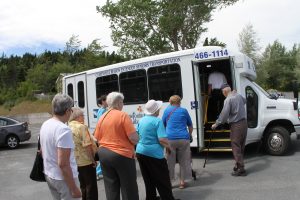
Ridership is consistently strong for the CREST bus. Photo credit: Brenda Reid.
In 2013, the provincial government chose Clarenville for one of five pilot projects for age-friendly transportation. A group of local partners including the Town of Clarenville and Random Age-Friendly Communities came together to create a public bus service for seniors. Clarenville Region Extended Seniors’ Transportation (CREST) began operating on July 14th, 2014. The CREST bus, operated entirely by volunteers, provides affordable transportation to seniors aged 60+ and people confined to a wheelchair aged 25+. Covering a 20 km radius, the bus serves 12 communities including Clarenville, Milton, George’s Brook, Harcourt, Random Heights, Elliott’s Cove, Snook’s Harbour, Deep Bight, Adeytown, Hillview, North West Brook, and Queen’s Cove. The service costs $2 per ride. CREST relies on the hard work of over 90 volunteers and the support of partners like Co-op 50/50, the Clarenville Lions’ Club, Bell Aliant Pioneers, Odd Fellows, the Royal Canadian Legion, and the Rotary Club. Call 466 1114 to book a ride or for more information.
Elder Care Housing Co-operative, Clarenville
Seniors in Clarenville are in great need of better affordable housing options. One organization that aims to provide that need is a group working to form a co-operative senior housing development in Clarenville. A committee with representatives from the Town of Clarenville, Eastern Health, Random Age Friendly Communities, the Lions’ Club, and the Rotary Club is planning a new affordable housing complex for local seniors. Having secured a $20,000 grant from the British Columbia Federation of Cooperatives, the committee is conducting a feasibility study to quantify the need for seniors’ affordable housing in the region and find best practices to inform what ultimately gets developed. The study will examine seniors’ housing case studies from around the world and recommend how to adapt these best practices to fit rural Newfoundland lifestyles and architecture. Contact Bob Gammon at lbgammon@eastlink.ca for more information.
Bonavista Region
Bonavista Living

The Boreal Diner, a new restaurant opened in 2016 in a building restored by Bonavista Living. Photo credit: Boreal Diner.
Bonavista’s cultural heritage stands at the heart of its economic and population growth. Boasting the largest inventory of built heritage in rural Newfoundland, the town’s heritage is also the foundation of Bonavista Living, a social enterprise that has been a major force in the community’s revitalization. This real estate company, which started with five houses in 2011 and a vision for positive impact, is now actively restoring 41 residential and commercial properties throughout Bonavista. Its core goals are to preserve and restore the town’s built heritage in a way that both protects and capitalizes on these cultural resources in order to create a more livable community for all. Furthering this vision are its sister companies: Bonavista Creative, which leases commercial space for new businesses, and Bonavista Creative Workshop, a producer of craft doors and windows. Together, the three companies have created over 60 jobs and are brought seven new businesses into the community, along with over 20 new full-time residents, in 2016 alone. Bonavista Living demonstrates how community development can preserve local character and identity through creative and mission-driven enterprise. Learn more at https://www.bonavistaliving.com/.
Fisher’s Loft, Port Rexton
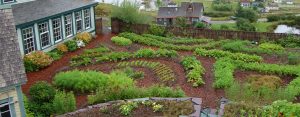
The garden at Fisher’s Loft is the source of many of the fresh vegetables served at the inn’s restaurant. Photo credit: Fisher’s Loft.
Fisher’s Loft started as a 4-room inn in 1997 in a heritage home in Port Rexton. The inn has a vision of place-based tourism, seeking to reflect the architectural and cultural character of the Bonavista Peninsula. The inn quickly became so popular that it was turning away more guests than it could accept, leading to a series of expansions over the years. Fisher’s Loft now offers 33 guestrooms, a restaurant, and a year-round conference centre. The inn keeps a garden and greenhouse where it grows much of the produce used in the kitchen. In addition, Fisher’s Loft is a patron of the arts, employing a local carpenter for much of its furniture, hosting an artist in residency program, and featuring the work of local artists. A major contributor to the Port Rexton and regional economy, Fisher’s Loft employs 22 local people and hosts approximately 4,500 guests per year. Learn more at http://fishersloft.com/.
Home from the Sea Sealers’ Memorial, Elliston
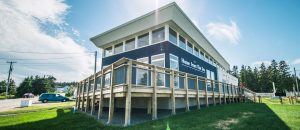
The John C. Crosbie Interpretation Centre. Photo credit: Home from the Sea.
In 2008, the Elliston Heritage Foundation embarked on an initiative to build a memorial to the 1914 Sealing Disasters in which 251 Newfoundland sealers died, including eight men from Elliston. Over the next 6 years this group, along with a provincial committee which was formed in 2012, raised $2.7M and, with the hard work of local advocates and support from donors around the province, built both the Memorial, pictured right, and the John C. Crosbie Interpretation Centre in 2014. The only museum of its kind in the world, the Centre tells the story of Newfoundland’s historic seal hunt, preserving this key part of regional and provincial heritage. In its first year, the museum attracted almost 6,000 visitors from around the world, making a significant contribution to Elliston’s economic renewal through cultural tourism. After a very successful first year, Home From the Sea plans to launch new programming such as interpretive hikes and school field trips. Visit Home From the Sea yourself or at http://www.homefromthesea.ca/.
The Aquarium at Champney’s West
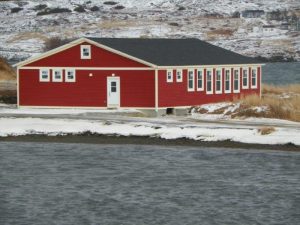
The newly constructed aquarium in Champney’s West. Photo credit: Champney’s West Heritage Group.
Champney’s West will soon have the region’s first public aquarium. An initiative of the Champney’s West Heritage Group, the Aquarium project hopes to help tell the story of Champney’s West as a traditional fishing community and provide an interactive experience to protect and preserve the ocean literacy of the community and people across the region. The aquarium will feature species from the local marine ecosystem, a trained marine biologist on site, interpretive walks, and plans to partner with local schools in delivering science curriculum to students. The Heritage Group is actively fundraising for an additional $34,000 to support its launch. The aquarium opened its doors in Summer 2016. Learn more at http://champneysisland.net/tag/aquarium-project/#.WHT9slUrKUk.
Trinity Historical Society
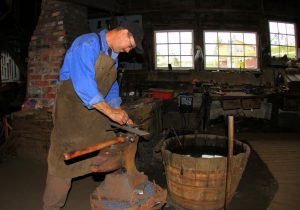
Historical demonstration in Trinity. Photo credit: Trinity Historical Society.
Trinity Historical Society Inc. was established in 1964 to preserve the unique built heritage of Trinity. With a year-round population of 137 (2011), Trinity was one of the first communities on the Bonavista Peninsula to develop its tourism sector. Today, Trinity Historical Society is a major contributor to the town’s cultural and economic life. The organization manages six historic buildings, including Green Family Forge and the Trinity Museum, which attracts 6,500 visitors per year. The Society is the second largest employer in Trinity, employing upwards of 35 people seasonally. In addition, the Society is a firm believer in regional cooperation and is working with several other heritage not-for-profit organizations across the Bonavista Peninsula in collaborative partnerships. Learn about the work of the Society at http://www.trinityhistoricalsociety.com/.
